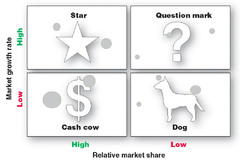Principles of Marketing; Quiz on Chapters 1-3 – Flashcards
Unlock all answers in this set
Unlock answersquestion
Marketing
answer
The process by which companies create value for customers and build strong customer relationships in order to capture value from customers in return.
question
The Marketing Process
answer
Creating value for customers, marketers capture value from customers in return.
question
Customer Needs
answer
States of felt deprivation.
question
Customer Wants
answer
The form human needs take as they are shaped by culture and individual personality.
question
Customer Demands
answer
Human wants that are backed by buying power.
question
Market Offerings
answer
Some combinations of products, services, information, or experiences offered to a market to satisfy a need or want.
question
Market Myopia
answer
The mistake of paying more attention to the specific products a company offers than to the benefits and experiences produced by these products.
question
Exchange
answer
The act of obtaining a desired object from someone by offering something in return.
question
Market
answer
The set of all actual and potential buyers of a product or service.
question
Marketing Management
answer
The art and science of choosing target markets and building profitable relationships with them. Answering who and how are we targeting.
question
Market Segmentation
answer
Dividing the market into segments of customers (different needs, characteristics, or behaviors, and who might require separate products or marketing programs).
question
Target Marketing
answer
Selecting which segments it will go after.
question
Value Proposition
answer
Set of benefits or values it promises to deliver to consumers to satisfy their needs.
question
Production Concept
answer
The idea that consumers will favor products that are available and highly affordable and that the organization should therefore focus on improving production and distribution efficiency.
question
Product Concept
answer
The idea that consumers will favor products that offer the most quality, performance, and features and that the organization should therefore devote its energy to making continuous product improvements.
question
Selling Concept
answer
The idea that consumers will not buy enough of the firm's products unless it undertakes a large-scale selling and promotion effort.
question
Marketing Concept
answer
A philosophy that holds that achieving organizational goals depends on knowing the needs and wants of target markets and delivering the desired satisfactions better than competitors do.
question
Societal Marketing Concept
answer
The idea that a company's marketing decisions should consider consumers' wants, the company's requirements, consumers' long-run interests, and society's long-run interests.
question
Marketing Mix (Four P's)
answer
-Product ;; Customer Solution -Price ;; Customer Cost -Place ;; Convenience -Promotion ;; Communication
question
Integrated Marketing Program
answer
Comprehensive plan that communicates and delivers the intended value to chosen customers.
question
Customer Relationship Management
answer
The overall process of building and maintaining profitable customer relationships by delivering superior customer value and satisfaction.
question
Customer-Perceived Value
answer
The customer's evaluation of the difference between all the benefits and all the costs of a marketing offer relative to those of competing offers (not just money, but time invested, options, energy, etc).
question
Customer Satisfaction
answer
The extent of which a product's perceived performance matches a buyer's expectations.
question
Customer-Managed Relationships
answer
Marketing relationships in which customers, empowered by todays' new digital technologies, interact with companies and with each other to shape their relationships with brands.
question
Consumer-Generated Marketing
answer
Brand exchanges created by consumers themselves--both invited and uninvited--by which consumers are playing an increasing role in shaping their own brand experiences and those of other consumers.
question
Partner Relationship Management
answer
Working closely with partners in other company departments and outside the company to jointly bring greater value to customers.
question
Customer Lifetime Value
answer
The value of the entire stream of purchases that the customer would make over a lifetime of patronage.
question
Share of Customer
answer
The portion of the customer's purchasing that a company gets in its product categories.
question
Customer Equity
answer
The total combined customer lifetime values of all of the company's customers.
question
Lifetime Value Analysis
answer
Costumer lifetime value is the value of the entire stream of purchases that the costumer would make over a lifetime of patronage.
question
Strategic Planning
answer
The process of developing and maintaining a strategic fit between the organization's goals and capabilities and its changing marketing opportunities
question
Mission Statement
answer
A statement of the organization's purpose--what it wants to accomplish in the larger environment.
question
Market Oriented Mission Statement
answer
Defines the business in terms of satisfying basic customer needs.
question
Business Portfolio
answer
The collection of businesses and products that make up the company.
question
Portfolio Analysis
answer
The process by which management evaluates the products and businesses that make up the company.
question
Growth-Share Matrix
answer
A portfolio-planning method that evaluates a company's SBUs in terms of its market growth rate and relative market share.
question
BCG Growth-Share Matrix

answer
One of four strategies for each SBU: Build Share: invest more Hold Share: invest enough to hold the share Harvest Share: milking its short--term cash flow regardless of the long-term effect. Divest Share: Selling it or phasing it out and using resources elsewhere.
question
Star
answer
High-growth, high-share businesses or products. They often need heavy investments to finance their rapid growth. Eventually their growth will slow down, and they will turn into cash cows.
question
Cash Cows
answer
Low-growth, high-share businesses or products. These established and successful SBUs need less investment to hold their market share. Thus, they produce a lot of the cash that the company uses to pay its bills and support other SBUs that need investment.
question
Question Marks
answer
Low-share business units in high-growth markets. They require a lot of cash to hold their share, let alone increase it. Management has to think hard about which question marks it should try to build into stars and which should be phased out.
question
Dogs
answer
Low-growth, low-share businesses and products. They may generate enough cash to maintain themselves but do not promise to be large sources of cash.
question
Problems with Matrix Approaches
answer
Difficult, time-consuming, and costly to implement. Provide little future advise.
question
Product/Market Expansion Grid
answer
A portfolio-planning tool for identifying company growth opportunities through market penetration, market development, product development, or diversification.
question
Market Penetration
answer
Company growth by increasing sales of current products to current market segments without changing the product.
question
Market Development
answer
Identifying and developing new markets for its current products
question
Product Development
answer
Company growth by offering modified or new products to current market segments.
question
Diversification
answer
Company growth through starting up or acquiring businesses outside the company's current products and markets.
question
Value Chain
answer
The series of internal departments that carry out value-creating activities to design, produce, market, deliver, and support a firm's products.
question
Value Delivery Network
answer
The network made up of the company, its suppliers, its distributors, and, ultimately, its customers who partner with each other to improve the performance of the entire system.
question
Marketing Strategy
answer
The marketing logic by which the company hopes to create customer value and achieve profitable customer relationships.
question
Market Segment
answer
A group of consumers who respond in a similar way to a given set of marketing efforts.
question
Market Targeting
answer
The process of evaluating each market segment's attractiveness and selecting one or more segments to enter.
question
Positioning
answer
Arranging for a product to occupy a clear, distinctive, and desirable place relative to competing products in the minds of target consumers.
question
Differentiation
answer
Actually differentiating the market offering to create superior customer value.
question
Marketing Mix
answer
The set of tactical marketing tools--product, price, place, and promotion-- that the firm blends to produce the response it wants in the target market.
question
Product
answer
The goods-and-services combination the company offers to the target market.
question
Price
answer
The amount of money customers must pay to obtain the product.
question
Place
answer
Includes company activities that make the product available to target consumers.
question
Promotion
answer
Activities that communicate the merits of the product and persuade target customers to buy it.
question
SWOT Analysis
answer
An overall evaluation of the company's strengths (S), weaknesses (W), opportunities (O), and threats (T).
question
Marketing Strategy
answer
Consists of specific strategies for target markets, positioning, the marketing mix, and marketing expenditure levels.
question
Marketing Implementation
answer
The process that turns marketing strategies and plans into marketing actions to accomplish strategic marketing objectives.
question
Marketing Control
answer
Measuring and evaluating the results of marketing strategies and plans and taking corrective action to ensure that the objectives are achieved.
question
Operating Control
answer
Checking ongoing performance against the annual plan and taking corrective action when necessary.
question
Return on Marketing Investment (or marketing ROI)
answer
The net return from a marketing investment divided by the costs of the marketing investment.
question
Return on Marketing Investment
answer
Views marketing expenditures as investments that produce returns in the form of more profitable customer relationships.
question
Marketing Environment
answer
The actors and forces outside marketing that affect marketing management's ability to build and maintain successful relationships with target customers
question
Microenvironment
answer
The actors close to the company that affect its ability to serve its customers--the company, suppliers, marketing intermediaries, customer markets, competitors, and publics.
question
Macroenvironment
answer
The larger societal forces that affect the microenvironment--demographic, economic, natural, technological, political, and cultural forces.
question
Marketing Intermediaries
answer
Firms that help the company to promote, sell, and distribute its goods to final buyers.
question
Public
answer
Any group that has an actual or potential interest in or impact on an organization's ability to achieve its objectives. Seven Types: 1. Financial Publics 2. Media Publics 3. Government Publics 4. Citizen-Action Publics 5. Local Publics 6. General Public 7. Internal Public
question
Demography
answer
The study of human populations in terms of size, density, location, age, gender, race, occupation, and other statistics.
question
Baby Boomers
answer
The 78 million people born during years following World War II and lasting until 1964.
question
Generation X
answer
The 45 million people born between 1965 and 1976 in the "birth dearth" following the baby boom.
question
Millennials or Generation Y
answer
The 83 million children of the baby boomers, born between 1977 and 2000.
question
Economic Environment
answer
Economic factors that affect consumer purchasing power and spending patterns.
question
Natural Environment
answer
Natural resources that are needed as inputs by marketers or that are affected by marketing activities. Trends: Increased shortages of raw material Increased population Increased government intervention Increased environmental sustainable strategies.
question
Environmental Sustainability
answer
Developing strategies and practices that create a world economy that the planet can support indefinitely.
question
Technological Environment
answer
Forces that create new technologies, creating new product and market opportunities.
question
Political Environment
answer
Laws, government agencies, and pressure groups that influence and limit various organizations and individuals in a given society.
question
Cultural Environment
answer
Institutions and other forces that affect society's basic values, perceptions, preferences, and behaviors.
question
Views on Responding
answer
Uncontrollable: React and adapt to forces in the environment Proactive: Aggressive actions to affect forces in the environment Reactive: Watching and reacting to forces in the environment.



